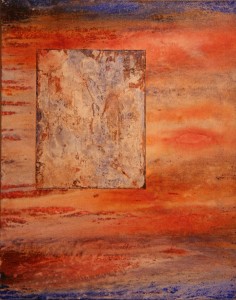Dear Artist,
The next time you have one of the instruments of your craft in your hand, take a minute to see exactly what it is, and try to rethink what it’s best cut out to do. Paint brushes are often asked to do things they were not meant to do. Whether from laziness or ignorance, the wrong sizes and shapes are pressed into service. Large passages are laboured through with little brushes, while detail is attempted with big ones. This is often because artists have their eyes on reality and not on illusion.
Here’s a simple idea that will almost always improve your work. It’s an easy one for even the most seasoned painters to forget. Simply think and select the brush that will most easily get around the passage at hand. Conversely, find passages that suit the brush you have in your hand. Demand that your brush be comfortable with its strokes. The whole brush, right down to the ferrule, gives confidence to the illusion you wish to make.

“Rehearsal of the Pas de Loup Orchestra at the Cirque d’Hiver”
oil on canvas 1878
by John Singer Sargent
Think how aptly the sumi-brush performs when used as intended. Think of the limner at limning, the fan at softening. See the uses of the Bright, Sharp, Round, Sable. Consider, above all, size. Particularly, move up in size of brush when you move up in size of work.
It’s safe to say we ought to start a painting with a broom and end with a whisk. In the name of giving a dash of élan and the impression of freshness and ease, try taking John Singer Sargent‘s advice and “start with a whisk and end with a broom.” Sargent loved to finish with a few casual or flamboyant strokes, larger than were needed, “a flash of talent.”
Best regards,
Robert
PS: “Illusions are art, and it is by art that we live, if we do.” (Elizabeth Bowen)
“And if you ever do a survey, you’ll find that people prefer illusion to reality, ten to one. Twenty, even.” (Judith Guest)
This letter was previously published as “Brush with illusion” on January 25, 2000.
Featured Artist
Painting is my passion and joy. My process is intuitive, though informed by good composition and design principles. I paint what I remember, or think about, or feel, or just what comes off my hands to the brush to the canvas. Texture and color are of primary importance to me. I typically choose my support, texture it, select my palette, and go. There is nothing more satisfying to me than watching paint run and move. I love the surprises. I experiment and learn constantly. It is a remarkable journey. One I am pleased to share with you.







10 Comments
Pingback: follow through | Anita H. Lehmann, Artist
I think this is all very true. There seems to be a growing trend among artists to want to paint with photographic detail. However, what we gain in detail we loose in mystery. In painting, less is more. Having too much information for the eye to see can lead to lack of focus – the eye darts everywhere without resting. Photos give graphic detail, paintings should give atmosphere and invite the viewer in. Sargent’s method of doing the big strokes at the end really works.
Yes, the large brush has it’s place and the smaller ones need to be brought out only when absolutely necessary for a final touch here and there. Thank you, Mike, for extending the explanation even further.
I think a combination of both photographic and throwaway brush strokes is, for me, perfection.
soon true-just got back from a 5 day workshop with Nancy Bush— near santa fe, n. m.
its art with soul…to say the least…
less is more
Mike I like very much what you said above. I used to oil paint with so much detail, that everyone that came to my Galleries Shows, would immediately go up about two feet away to see the detail. With all the detail I put into my oil paintings you could easily see my painting’s 10 to 15 feet away. A friend mentioned that I should try ‘Plein Air’ painting. Well with a lot of practice and learning to stand away from my canvases to paint with long handle brushes. I’m enjoying my oil painting so much better! What is really nice is when I put up my older detail paintings beside my new paintings of Plein Air paintings they both look the same at a distant with plenty of detail, until you walk up closely! Now it’s not so pains taking for detail. Grant S.
Mike Barr- This comment: Having too much information for the eye to see can lead to lack of focus – the eye darts everywhere without resting…
Is exactly what I’m doing- with utter intention- and a total all-consuming focus on too much information! I have an INTENT TO OVERWHELM. There is nowhere for the eye to rest. Therefore- the eye DANCES all over the piece- right up until the split second your mind explodes. If the piece is impossible to look at- its success is of the highest order- and I’ve succeeded in the grandest most magnificent way possible. And I had a friend visit a show of mine back east and describe my work in exactly this way…
I understand Bruce, but you are not talking about painting here.
No- of course I’m not talking about the reality of creating a ‘painting’… but with abstract art and op-art and digital art- while the rules may be perceived to be the same- the rules have also changed…
I agree.